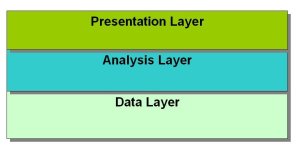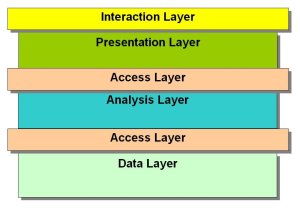discussed in detail on the Taskforce blog.Diagram 1 - the ‘traditional approach’

The emphasis of much web development to date has been on the presentation of the data to the public.
The assumption was that a particular website would be the unique interface to a particular set of data.
This meant that little or no thought might have been given to how anyone else would use the data set in question.
Sometimes the data and any analysis of it could be unpicked from such a site but in many instances this would be extremely difficult.
Diagram 2 - a Power of Information model

Thinking has moved on over recent years with a developing understanding of the importance of separating data from its presentation. If nothing else, this allows for simpler changes to the presentation layer as, for example, websites are redesigned.
PRESENTATION LAYER - the public-facing front end, typically a set of web pages
ACCESS LAYER - all the information needed to access the data, including technical, legal and commercial aspects
ANALYSIS LAYER - any form of interpretation of the raw data, typically for summary presentation
ACCESS LAYER - all the information needed to access the data, including technical, legal and commercial aspects
DATA LAYER - the raw data sets
The Taskforce judges that to realise the power of much public information a different approach is needed to the way public data sets are treated when published on the web. There is a need for several access layers to the data. These layers must address all the issues that are necessary to enable use of the data. These typically include technical issues such as file formats, intellectual property issues such as copyright, and commercial issues such as pricing where applicable. The access layer is discussed in more detail here. Access to data allows many other actors to create their own analyses of it. A further Access Layer could allow reuse of the output of the analysis activity. This must again address any technical, intellectual property and commercial issues. With the Access Layers in place there is scope for multiple web presentations of the data. Additional value can be generated through the ability to interact with a community around the data.The full realisation of the power of the information is realised when all layers are in place with the architecture designed to offer opportunities for interaction.